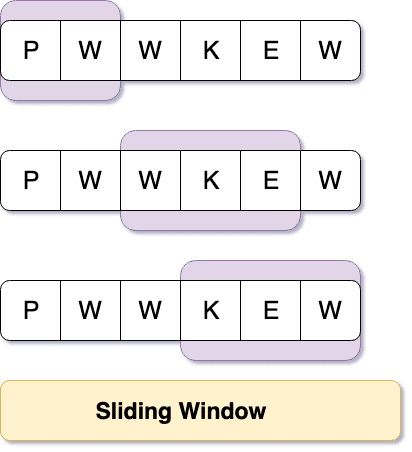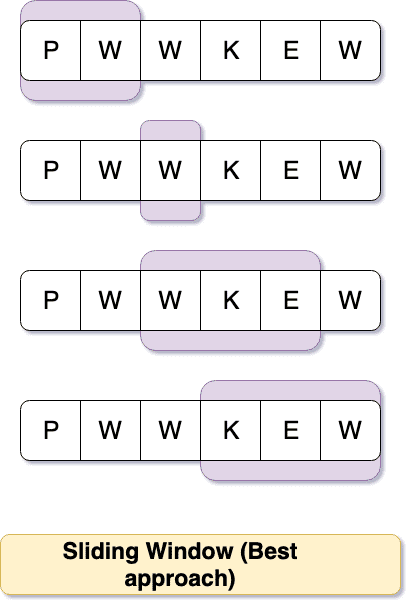Crawler Log Folder - minimum number of operations needed to go back to the main folder after the change folder operations.
Problem The Leetcode file system keeps a log each time some user performs a…
August 10, 2019
Given a string, find the length of the longest substring without repeating characters.
Example 1:
Input: "abcabcbb"
Output: 3
Example 2:
Input: "bbbbb"
Output: 1
Example 3:
Input: "pwwkew"
Output: 3As the question demands substring. Why not we find out what are the substrings out of the input strings first. Lookout for the steps:
You got the answer. Lets look at the code:
public class SimpleSolution {
private String str;
public SimpleSolution(String str) {
this.str = str;
}
private Set<String> getAllUniqueSubstrings() {
Set<String> res = new HashSet<>();
int l = this.str.length();
for (int i=0; i<l; i++) {
for (int j=i+1; j<l; j++) {
res.add(this.str.substring(i, j));
}
}
return res;
}
//Checks if the string is having unique characters
private boolean isUniqueChars(String substring) {
Set<Character> chars = new HashSet<>();
int l = substring.length();
for (int i=0; i<l; i++) {
if (chars.contains(substring.charAt(i))) {
return false;
}
chars.add(substring.charAt(i));
}
return true;
}
public String getResult() {
//Get all substrings
Set<String> substrings = this.getAllUniqueSubstrings();
//check their lengths, and return string with highest length
String result = null;
int maxLen = 0;
for (String substring : substrings) {
if (this.isUniqueChars(substring)) {
if (substring.length() > maxLen) {
result = substring;
maxLen = substring.length();
}
}
}
return result;
}
}Overall complexity of this program is: O(n^2)
In above approach, our main time is in calculating substrings and checking if it has unique character. Lets have a look at the Sliding Window solution. We can maintain a HashSet to check if our substring has unique character or not. And, two variables for maintaining a sliding window.

Lets look at the code:
public class OptimizedSolution {
private String str;
public OptimizedSolution(String str) {
this.str = str;
}
public String getResult() {
int l = this.str.length();
Set<Character> set = new HashSet<>();
int i=0;
int j=0;
String maxStr = "";
while (i < l && j < l) {
if (!set.contains(this.str.charAt(j))) {
set.add(this.str.charAt(j));
j++;
String s = this.str.substring(i, j);
if (s.length() > maxStr.length()) {
maxStr = s;
}
}
else {
set.remove(this.str.charAt(i));
i++;
}
}
return maxStr;
}
}Overall complexity of this program is: O(n) At the max, the program will run for O(2n) which is nearly equal to O(n)
In above approach, we are moving left side of sliding window one by one on encountering a duplicate character. Our objective is to move that left pointer of sliding window to the occurance of duplicate character plus 1.

Lets look at the code.
public class MoreOptimizedSolution {
private String str;
public MoreOptimizedSolution(String str) {
this.str = str;
}
public String getResult() {
Map<Character, Integer> map = new HashMap<>();
int l = this.str.length();
int i=0; int j=0;
String maxStr = "";
for (; j<l; j++) {
if (map.containsKey(this.str.charAt(j))) {
i = Math.max(map.get(this.str.charAt(j)), i);
}
if (j-i+1 > maxStr.length()) {
maxStr = this.str.substring(i, j+1);
}
map.put(this.str.charAt(j), j+1);
}
return maxStr;
}
}The overall runtime of this code is: O(n), but is using extra space.
Problem The Leetcode file system keeps a log each time some user performs a…
Problem Statement You are given a rows x cols matrix grid. Initially, you are…
Young Tableau A a X b matrix is Young Tableau if all rows(from left to right…
Problem Statement Given n non-negative integers a1, a2, …, an , where each…
Problem Implement an algorithm to determine if a string has all the characters…
Problem Statement Given a linked list, swap every two adjacent nodes and return…
Introduction In this post we will see following: How to schedule a job on cron…
Introduction There are some cases, where I need another git repository while…
Introduction In this post, we will see how to fetch multiple credentials and…
Introduction I have an automation script, that I want to run on different…
Introduction I had to write a CICD system for one of our project. I had to…
Introduction Java log4j has many ways to initialize and append the desired…